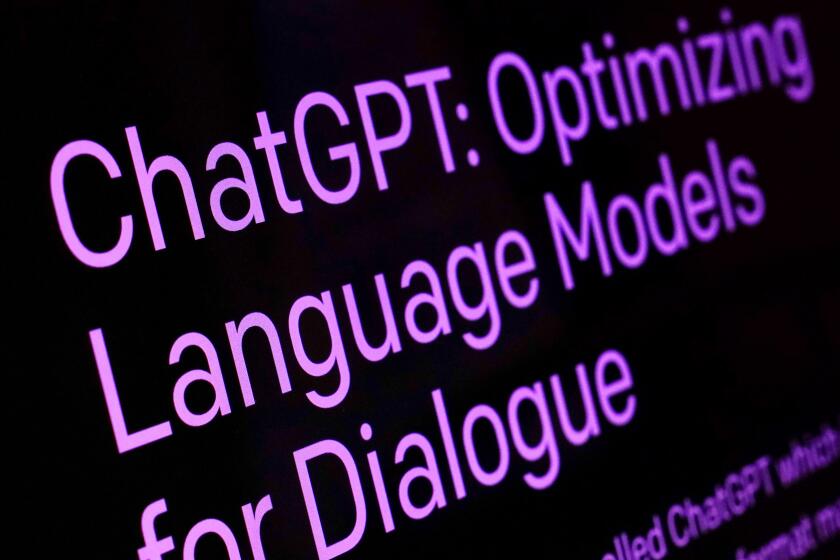The writers’ strike is partly about AI. They’re right to worry

- Share via
The Writers Guild of America and the Alliance of Motion Picture and Television Producers agree on one thing: Artificial intelligence is coming. At the same time, they disagree fundamentally on an issue that we will all soon struggle with.
Can the owners of capital assets (the studios) use AI to substantially replace workers (the writers) and tilt the balance of power in their favor? Or is there a way to address the entirely reasonable demand from writers that this increasingly capable software remain a tool under the control of workers?
Silicon Valley has long been infatuated with “machine intelligence,” the goal of creating software that can mimic what humans do. The technology arms race to create human-like abilities has recently become a dangerous obsession, threatening to destroy millions of good jobs. But attempting to stop the development of these algorithms is not the right solution.
As AI is becoming more ubiquitous, the Writers Guild is proposing some guidelines for how to regulate it and avoid writers being cut out of the creation of TV and film.
We need, instead, a pivot on the part of inventors, entrepreneurs and policymakers toward a focus on “machine usefulness,” the idea that computers should primarily enhance human capabilities. But this needs to be combined with an explicit recognition that any resulting productivity gains must be shared with workers, in terms of higher incomes and better working conditions.
More educated and better resourced workers — think of many on Wall Street — will probably figure some of this out for themselves. The really pressing problem is among low-wage workers whom new technology — for example, at Amazon — already puts under greater surveillance and squeezes to work harder, in more difficult conditions.
We have been grappling with the consequences of machines replacing people for nearly 1,000 years. The idea that automation necessarily creates shared prosperity is an illusion — that’s not what happened in medieval Europe, or in the first century of the Industrial Revolution, or in the digital transformation we have experienced since 1980.
In our lifetimes, the increasing use of computers has contributed significantly to the loss of well-paid blue- and white-collar jobs, a hollowing out of the middle class in many parts of the U.S., and the widening of income inequality.
The digital transformation boosted productivity, but not by as much as expected and the benefits were not widely shared. The internet was supposed to let information run free but resulted in the creation of some very powerful companies that are now using our data — without proper permissions — to train their algorithms. And if you want a glimpse of how much damage can be wrought by reckless innovation, look at social media.
AI could be bigger than the sum of these elements — precisely because it is the culmination of more than four decades of innovation. Think about the impact of electricity, which runs continually in the background of our lives. From the late 19th century, electricity transformed industrial production and every aspect of people’s lives. However, this change took several decades to take effect, allowing plenty of time for new jobs to be created and for labor unions to demand higher pay in return for greater productivity.
Bloom’s Taxonomy, a framework that describes levels of thinking, is a better tool for determining AI capabilities than comparing them with humans’.
We now face a mad on-rush of generative AI. Can we avoid further widening the wealth gap with the advent of AI, which could replace lower-skilled jobs — and even high-skilled jobs — as it becomes better trained?
We need to create incentives for innovators to apply AI-related technology to address real human problems — and to shift away from developing the tools of social oppression. First and foremost, this requires shifting the social narrative about who controls technology (a few big companies), who benefits when technology changes (the people who run those companies), and what we really want to get from technology (not what our techno-elite has in mind). Once people are grappling more explicitly with these issues, we can start to redirect technology with four action items.
First, the U.S. government should immediately allocate research funding to projects focused on creating human complementary technologies throughout the economy. In sectors such as education, healthcare and other public priorities, the government should commit to purchase and help deploy appropriate technology, subject to existing standards.
The history of federal research and development funding working in tandem with public procurement is clear: If you support new breakthrough ideas and also create a big potential market for specific technological solutions, private innovation will move decisively in that direction. This is how we led the world in developing antibiotics, jet aircraft and semiconductors.
Second, voluntary data unions should be created, including anyone who puts images on the internet, ranging from professional agencies to individuals with family photos. AI companies are currently using these images without permission and without compensation. Lawsuits should be brought to stop this practice, which in many instances is blatant and outrageous copyright violation.
Third, guidelines from the Occupational Safety and Health Administration should be updated to prevent the most intrusive forms of workplace surveillance. So-called “bossware” is already spreading widely, and generative AI threatens to make this much more powerful and oppressive. Updating existing regulations can be done and does not require congressional approval.
Finally, our current fiscal system discourages the hiring of workers and encourages their replacement with machines and algorithms. One step is to eliminate payroll taxes (which raise the cost of hiring people) and replace them with a more effective tax system on corporate profits, by raising tax rates and ending the myriad loopholes around “carried interest” for private equity funds.
Making the AI revolution more responsive to workers’ and societal needs will take all kinds of regulatory changes. We need to start thinking creatively about the controls and incentives that will guide this technology’s future.
Daron Acemoglu and Simon Johnson are professors at MIT and co-authors of the forthcoming book “Power and Progress: Our 1,000-Year Struggle Over Technology & Prosperity.”
More to Read
A cure for the common opinion
Get thought-provoking perspectives with our weekly newsletter.
You may occasionally receive promotional content from the Los Angeles Times.








